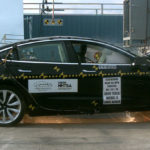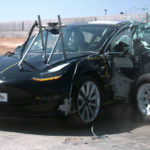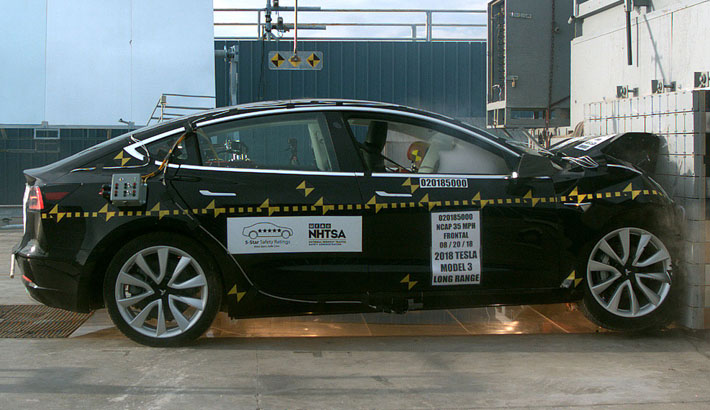
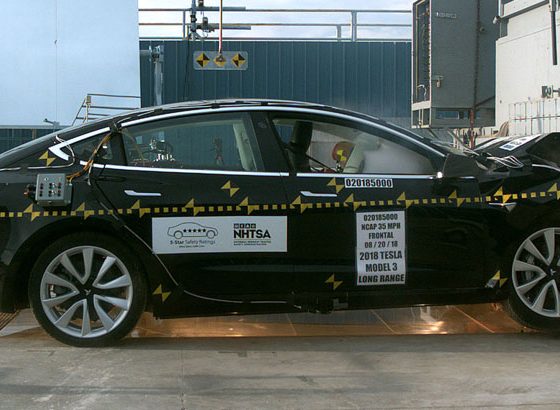
Investor's Corner
Tesla Model 3 earns flawless 5-Star safety rating from NHTSA
Joining its larger siblings, the Tesla Model 3 has been given a 5-Star Safety Rating by the National Highway Traffic Safety Administration (NHTSA). The NHTSA tested the Model 3 on frontal crash, side crash, and rollover safety; and in all the categories and subcategories of the organization’s tests, the Model 3 performed superbly, displaying a level of industry-leading driver and passenger safety.
The NHTSA’s Recommended Safety Technologies, such as forward collision warning systems, dynamic brake support, crash imminent braking, and lane departure warning features, were also standard on the Model 3. Following are the results from the NHTSA’s safety tests on the Model 3.
- The Tesla Model 3’s ratings from the National Highway Traffic Safety Administration. [Credit: NHTSA]
- The Tesla Model 3’s ratings from the National Highway Traffic Safety Administration. [Credit: NHTSA]
- The Tesla Model 3’s ratings from the National Highway Traffic Safety Administration. [Credit: NHTSA]
- The Tesla Model 3’s ratings from the National Highway Traffic Safety Administration. [Credit: NHTSA]
The Tesla Model 3’s ratings from the National Highway Traffic Safety Administration. [Credit: NHTSA]
With the Model 3 getting its official NHTSA score, Tesla now holds the distinction of being an automaker whose entire lineup of production vehicles have 5-Star safety ratings. Just like the Model 3, the Tesla Model X received perfect scores in all of the NHTSA’s frontal crash, side crash, and rollover tests. Back in 2013, the Tesla Model S performed so well during the NHTSA’s testing, the vehicle ended up breaking the organization’s crash-testing gear.
Even before the release of the NHTSA’s official ratings for the Model 3, Elon Musk has been lauding the electric sedan’s safety features. In a post last month on Twitter, Musk noted that the absence of a fossil fuel-powered engine in the Model 3 gives the car longer crumple zones. Musk also pointed out that the Model 3 has the “best safety of any midsize car.”
Such statements seem to be acknowledged by a number of Model 3 accidents this year, including a high-speed crash on the I-90 tunnel in Seattle, WA resulting from what appeared to be a street race between a BMW M4 and a Chevrolet Camaro SS. A Model 3 involved in a head-on collision at 60 mph earlier this year also resulted in the driver walking away with just a swollen ankle.
- The Tesla Model 3 gets crash tested by the National Highway Traffic Safety Administration. [Credit: NHTSA]
- The Tesla Model 3 gets crash tested by the National Highway Traffic Safety Administration. [Credit: NHTSA]
- The Tesla Model 3 gets crash tested by the National Highway Traffic Safety Administration. [Credit: NHTSA]
The Tesla Model 3 gets crash tested by the National Highway Traffic Safety Administration. [Credit: NHTSA]
Back in May, the Insurance Institute for Highway Safety (IIHS), a nonprofit funded by auto insurers dedicated to reducing the number of accidents on the road, also gave the Model 3 a “Superior” front crash avoidance rating. During its tests, the Model 3 performed particularly well in the crash avoidance and mitigation category, thanks to the vehicle’s Forward Collision Warning, its low-speed autobrake, and its high-speed autobrake systems.
This is not to say that the Model 3’s safety ratings have flawless from the beginning. Consumer Reports initially denied the Model 3 its coveted “Recommended” rating due to the vehicle’s variance in braking distances, which Tesla promptly addressed through an over-the-air software update. Consumer Reports later retested the Model 3, giving it a “Recommended” rating.
The Model 3’s all-electric design is a key factor in its safety ratings. Since the vehicle does not have a front-mounted engine and rear-mounted gas tank, as can be found on fossil fuel-powered cars, the Model 3 has extra large crumple zones that absorb energy during high-speed collisions. Tesla’s use of ultra-high-strength steel and aluminum for the Model 3’s body structure, as well as the vehicle’s floor-mounted battery pack, provide further structural rigidity to the electric sedan.
Watch the Model 3’s safety tests in the videos below.

Investor's Corner
SpaceX IPO is coming, CEO Elon Musk confirms
However, it appears Musk is ready for SpaceX to go public, as Ars Technica Senior Space Editor Eric Berger wrote an op-ed that indicated he thought SpaceX would go public soon. Musk replied, basically confirming it.

Elon Musk confirmed through a post on X that a SpaceX initial public offering (IPO) is on the way after hinting at it several times earlier this year.
It also comes one day after Bloomberg reported that SpaceX was aiming for a valuation of $1.5 trillion, adding that it wanted to raise $30 billion.
Musk has been transparent for most of the year that he wanted to try to figure out a way to get Tesla shareholders to invest in SpaceX, giving them access to the stock.
He has also recognized the issues of having a public stock, like litigation exposure, quarterly reporting pressures, and other inconveniences.
However, it appears Musk is ready for SpaceX to go public, as Ars Technica Senior Space Editor Eric Berger wrote an op-ed that indicated he thought SpaceX would go public soon.
Musk replied, basically confirming it:
As usual, Eric is accurate
— Elon Musk (@elonmusk) December 10, 2025
Berger believes the IPO would help support the need for $30 billion or more in capital needed to fund AI integration projects, such as space-based data centers and lunar satellite factories. Musk confirmed recently that SpaceX “will be doing” data centers in orbit.
AI appears to be a “key part” of SpaceX getting to Musk, Berger also wrote. When writing about whether or not Optimus is a viable project and product for the company, he says that none of that matters. Musk thinks it is, and that’s all that matters.
It seems like Musk has certainly mulled something this big for a very long time, and the idea of taking SpaceX public is not just likely; it is necessary for the company to get to Mars.
The details of when SpaceX will finally hit that public status are not known. Many of the reports that came out over the past few days indicate it would happen in 2026, so sooner rather than later.
But there are a lot of things on Musk’s plate early next year, especially with Cybercab production, the potential launch of Unsupervised Full Self-Driving, and the Roadster unveiling, all planned for Q1.
Investor's Corner
Tesla Full Self-Driving statistic impresses Wall Street firm: ‘Very close to unsupervised’
The data shows there was a significant jump in miles traveled between interventions as Tesla transitioned drivers to v14.1 back in October. The FSD Community Tracker saw a jump from 441 miles to over 9,200 miles, the most significant improvement in four years.

Tesla Full Self-Driving performance and statistics continue to impress everyone, from retail investors to Wall Street firms. However, one analyst believes Tesla’s driving suite is “very close” to achieving unsupervised self-driving.
On Tuesday, Piper Sandler analyst Alexander Potter said that Tesla’s recent launch of Full Self-Driving version 14 increased the number of miles traveled between interventions by a drastic margin, based on data compiled by a Full Self-Driving Community Tracker.
🚨 Piper Sandler reiterated its Overweight rating and $500 PT on Tesla $TSLA stock
Analyst Alexander Potter said FSD is near full autonomy and latest versions showed the largest improvement in disengagements, from 440 miles to 9,200 miles between critical interventions pic.twitter.com/u4WCLfZcA9
— TESLARATI (@Teslarati) December 9, 2025
The data shows there was a significant jump in miles traveled between interventions as Tesla transitioned drivers to v14.1 back in October. The FSD Community Tracker saw a jump from 441 miles to over 9,200 miles, the most significant improvement in four years.
Interestingly, there was a slight dip in the miles traveled between interventions with the release of v14.2. Piper Sandler said investor interest in FSD has increased.
Full Self-Driving has displayed several improvements with v14, including the introduction of Arrival Options that allow specific parking situations to be chosen by the driver prior to arriving at the destination. Owners can choose from Street Parking, Parking Garages, Parking Lots, Chargers, and Driveways.
Additionally, the overall improvements in performance from v13 have been evident through smoother operation, fewer mistakes during routine operation, and a more refined decision-making process.
Early versions of v14 exhibited stuttering and brake stabbing, but Tesla did a great job of confronting the issue and eliminating it altogether with the release of v14.2.
Tesla CEO Elon Musk also recently stated that the current v14.2 FSD suite is also less restrictive with drivers looking at their phones, which has caused some controversy within the community.
Although we tested it and found there were fewer nudges by the driver monitoring system to push eyes back to the road, we still would not recommend it due to laws and regulations.
Tesla Full Self-Driving v14.2.1 texting and driving: we tested it
With that being said, FSD is improving significantly with each larger rollout, and Musk believes the final piece of the puzzle will be unveiled with FSD v14.3, which could come later this year or early in 2026.
Piper Sandler reaffirmed its $500 price target on Tesla shares, as well as its ‘Overweight’ rating.
Investor's Corner
Tesla gets price target boost, but it’s not all sunshine and rainbows
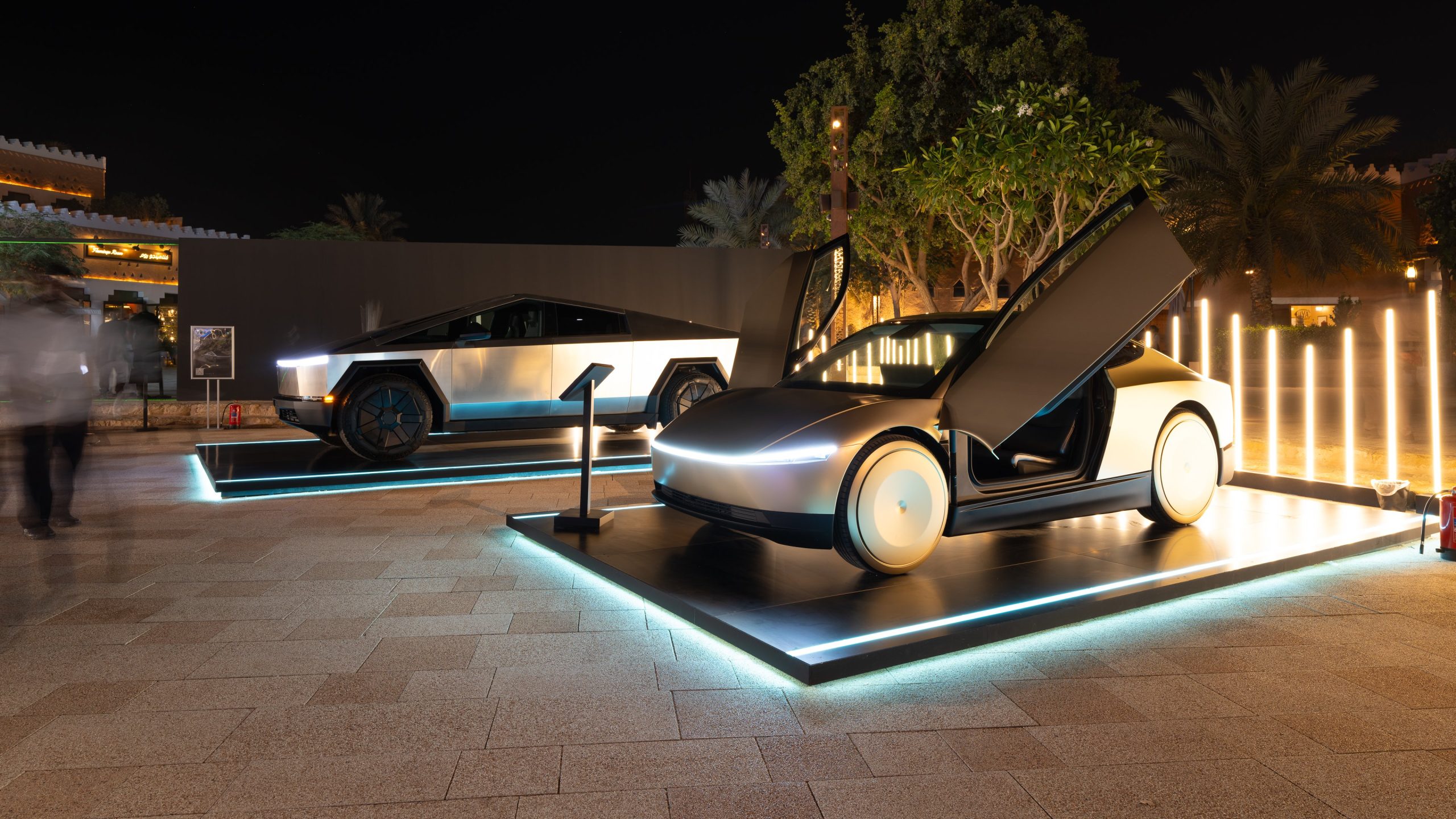
Tesla received a price target boost from Morgan Stanley, according to a new note on Monday morning, but there is some considerable caution also being communicated over the next year or so.
Morgan Stanley analyst Andrew Percoco took over Tesla coverage for the firm from longtime bull Adam Jonas, who appears to be focusing on embodied AI stocks and no longer automotive.
Percoco took over and immediately adjusted the price target for Tesla from $410 to $425, and changed its rating on shares from ‘Overweight’ to ‘Equal Weight.’
Percoco said he believes Tesla is the leading company in terms of electric vehicles, manufacturing, renewable energy, and real-world AI, so it deserves a premium valuation. However, he admits the high expectations for the company could provide for a “choppy trading environment” for the next year.
He wrote:
“However, high expectations on the latter have brought the stock closer to fair valuation. While it is well understood that Tesla is more than an auto manufacturer, we expect a choppy trading environment for the TSLA shares over the next 12 months, as we see downside to estimates, while the catalysts for its non-auto businesses appear priced at current levels.”
Percoco also added that if market cap hurdles are achieved, Morgan Stanley would reduce its price target by 7 percent.
Perhaps the biggest change with Percoco taking over the analysis for Jonas is how he will determine the value of each individual project. For example, he believes Optimus is worth about $60 per share of equity value.
He went on to describe the potential value of Full Self-Driving, highlighting its importance to the Tesla valuation:
“Full Self Driving (FSD) is the crown jewel of Tesla’s auto business; we believe that its leading-edge personal autonomous driving offering is a real game changer, and will remain a significant competitive advantage over its EV and non-EV peers. As Tesla continues to improve its platform with increased levels of autonomy (i.e., hands-off, eyes-off), it will revolutionize the personal driving experience. It remains to be seen if others will be able to keep pace.”
Additionally, Percoco outlined both bear and bull cases for the stock. He believes $860 per share, “which could be in play in the next 12 months if Tesla manages through the EV-downturn,” while also scaling Robotaxi, executing on unsupervised FSD, and scaling Optimus, is in play for the bull case.
Will Tesla thrive without the EV tax credit? Five reasons why they might
Meanwhile, the bear case is placed at $145 per share, and “assumes greater competition and margin pressure across all business lines, embedding zero value for humanoids, slowing the growth curve for Tesla’s robotaxi fleet to reflect regulatory challenges in scaling a vision-only perception stack, and lowering market share and margin profile for the autos and energy businesses.”
Currently, Tesla shares are trading at around $441.




